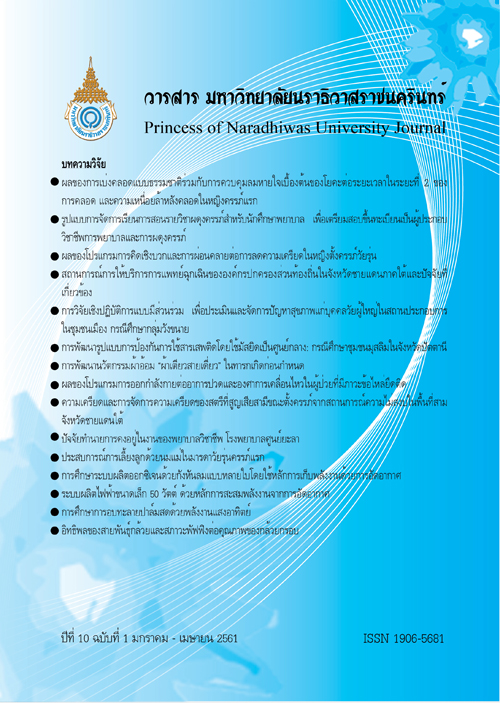The Emergency Medical Services of Local Administrative Sectors in the Southern Borders, and Related Factors
Keywords:
Emergency medical services, Local administrative sector, Southern bordersAbstract
This descriptive study aimed to describe 1) the situation of the emergency medical services
(EMS) organized by Local Administrative Sectors (LAS) in the Southern Borders, 2) factors related to EMS
provision. The population was the chief executive of LAS in the Southern Borders who provided or none of
EMS. The data were collected using the questionnaire. on the management and operation of EMS of LAS.
Content validity index was judged by 3 experts. The reliability of the Questionnaire was verified by using
the Kuder-Richardson coefficient, yielding values of 0.94. Data analyzed by descriptive statistics including
percentage, mean, standard deviation, median, interquartile range and analysis of factors associated with
EMS provision by LAS in the Southern Borders using Binary Logistic Regression.
The returned questionnaires was 273 (64.8%) which showed that about 53.5 % of LAS have provided
EMS which stated in the written policies of EMS (73.3%) and the adequate budget to support (67.1%). The
majority of them had a set of operations with basic emergency medical personnel (namely FR) (94.5%), and
had assigned a responsible person for this job (84.9%). The top activities performed which achieved the
EMS standards more than 80% were ability to communicate with the dispatch center / hospital for assistance
(94.5%), followed by having a received call notification 24 hours (93.8 %) respectively. The provision which
performed less than 60 % of the standards was using a GPS navigation system (20.5%). The LAS who has
not provided the EMS (46.5 %) due to insufficient budget (81.9%). The important factors that can increase
the opportunities of LAS to operate the EMS system in the Southern borders were 1) having the written
policy of the EMS 2) budget to support the EMS and 3) a concern of administrator. The findings from the
study can be used as a basis for better or effective development of EMS provision by LAS in the area.
References
Keawnui, S. & Panasanachee, S. (2014). Statistics of the unrest in southern provinces by the year 2014:the least events in 11 years. Deep South Incident Database (DSID), Center for Conflict Studies andCultural Diversity (CSCD). Prince of Songkla University, Pattani Campus. Retrieved January 8,2013, from https://www.deepsouthwatch.org/node/6633. (in Thai).
Kraonual, S. (2008). Impacts of the Unrest Situation in the Three Southern Border Provinces on Health Care Service System. Retrieved September 24, 2014, from https://www.deepsouthwatch.org/sites/default/files/Sunee%20-%20HealthSystem.pdf. (in Thai).
Lacharojn, W. (2008). The Relationship Factor of Participation of Local Authorities or Organization for Emergency Medical System in Pathumthani Province. Khon Kaen Hospital Medical Journal, 32(7), 68-77. (in Thai).
National Institute for Emergency Medicine. (2011). Implementation of Emergency Medical Systems of Local Administrative. Bangkok: New Thammada Press.
National Institute for Emergency Medicine. (2013). Annual Report 2012 National Institute of Emergency Medicine. Bangkok: So.Phichit Printing. (in Thai).
National Institute of Emergency Medicine. (2014). The gap of Thai Emergency Medicine: Report Emergency Medical Service System 2013. Bangkok: NP Press.
Sangthong, S., Poonpunamnua, T., Suvakan, C., Ajhan, P., & Sawat Prasit, K. (2015). Report on quality assessment and compensation for emergency medical services 2015. Bangkok: Art Equit Limited. (in Thai).
Suriyapantri, M. & Chimkul, L. (2008). Local Government Participation in Emergency Medical Services in Nangrong District, Buriram Province. Research Results 2008 Provincial Health Office. Buriram: Provincial Health Office. (in Thai).
Suriyawongpaisarn, P., Srithamrongsawat, S., Hempisut, P., Aueasiriwon, B., Pholpark, A., Wannasri, A., & Bamrungkhet, W. (2013). The Emergency Management System of the Regional Emergency Medical System. Health Insurance System Research Office (HISRO). Health Systems Research Institute (HSRI). (in Thai).
Suwanarak, U., Suwannarak, S., Pappila, N., Kuhakarn, R.,Chusang, S., & Somton, A. (2015). The gap Emergency Medical Thailand: Report Emergency Medical Service System 2014. Bangkok: National Institute of Emergency Medicine. (in Thai).
Suwanarak, U., Suwannarak, S., Yuppipol, P., Kuhakarn, R.,Chusang, S., & Somton, A. (2016). The gap Emergency Medical Thailand: Report Emergency Medical Service System 2015. Bangkok: National Institute of Emergency Medicine. (in Thai).
Tienthavorn,T. (2013). Review of the development of the emergency medical service in Canada. International
Experiences on Emergency Medical Services. Health Insurance System Research Office (HISRO). (in Thai).
Wongthanavasu, S. & Sudhipongpracha, T., (2013). Analysis of the Capacity and Preparedness of Local
Administrative Organizations and Citizens in Health Management. College of Local Administration, Khon Kaen University. (in Thai).




